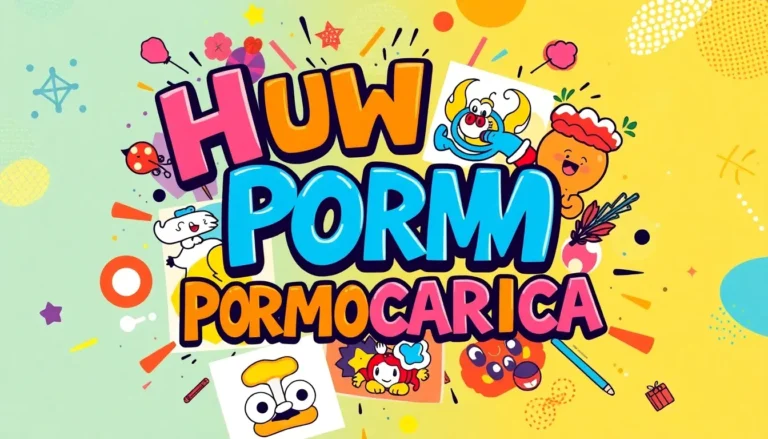In a world where distractions lurk around every corner, technology-enhanced reading apps are like a superhero for book lovers. They swoop in to save the day, transforming the way readers engage with their favorite stories. Imagine diving into a novel that not only entertains but also tracks your progress, offers interactive features, and even has a built-in dictionary to rescue you from those pesky words you can’t pronounce.
These apps are more than just digital pages; they’re your personal reading companions, ready to make your literary journey smoother and more enjoyable. Whether you’re a casual reader or a bookworm on a mission, these tools can elevate your reading experience from “meh” to “wow!” So grab your device, and let’s explore how technology is revolutionizing the art of reading, one app at a time.
Table of Contents
ToggleOverview Of Technology-Enhanced Reading Apps
Technology-enhanced reading apps transform the reading landscape for users. These applications provide features that increase focus and foster engagement. Users can track their reading progress, which encourages them to read consistently. Interactive elements such as quizzes and multimedia content enrich the learning experience.
Built-in dictionaries simplify comprehension by allowing readers to look up unfamiliar words instantly. Readers can customize the app’s interface, tailoring it to their preferences for a personalized experience. Many of these apps include community features that enable sharing insights and discussing books with others.
Reading apps often integrate with various devices, ensuring access to books anywhere, anytime. Data shows that more than 80% of readers prefer a blend of traditional and digital formats, highlighting the demand for versatility. Readers can also find annotations and notes within these apps, making it easier to reflect on specific passages or themes.
These applications frequently update their content, providing access to the latest titles and diverse genres that cater to varying interests. Furthermore, apps often support multiple languages, promoting accessibility for readers worldwide. Users experience a more interactive reading journey, ultimately deepening their understanding of the material.
Engagement levels increase thanks to gamification elements, which make reading a dynamic and enjoyable activity. The future of reading lies in these technology-enhanced apps, merging the love of literature with innovative digital tools.
Benefits Of Technology-Enhanced Reading Apps

Technology-enhanced reading apps offer significant advantages, transforming how individuals interact with literature. Users experience improved focus and enjoyment, as these tools cater to modern reading habits.
Enhanced Engagement
Enhanced engagement results from interactive features like quizzes and multimedia content. Quizzes compel readers to think critically about the material, reinforcing comprehension. Multimedia content enriches the reading experience by providing visuals and audio, making books come alive. Readers can explore annotations and highlight key passages, further deepening their connection with the text. Users also benefit from community forums that facilitate discussions about favorite books, fostering a sense of belonging. Built-in social sharing options encourage users to recommend titles to friends, creating a vibrant network of book lovers. Overall, engaging features contribute to active participation rather than passive consumption of content.
Personalized Learning
Personalized learning transforms the reading journey through customized experiences. Apps often allow users to track reading habits and set specific goals, fostering accountability and consistency. Users receive recommendations based on their preferences and historical reading data, ensuring a tailored selection of titles. Different reading levels and adjustable font sizes accommodate diverse audiences, making literature accessible. Built-in dictionaries make it easier to learn new vocabulary, enhancing language skills while reading. By providing annotations and notes, these apps enable users to engage with the material in a personal way. This unique approach to reading creates a more meaningful and individualized experience.
Popular Technology-Enhanced Reading Apps
Numerous apps enhance the reading experience, providing unique features that cater to diverse reading preferences. Readers can explore these applications to find their perfect digital companion.
App 1: Features And Reviews
Kindle app stands out with its extensive library of eBooks. Users appreciate the adjustable font sizes and background colors, allowing customization for comfort. Built-in dictionaries aid vocabulary development while note-taking features encourage reflection. Reviews highlight its seamless integration with Amazon services and the ease of purchasing titles. Syncing across devices ensures readers never lose their place, making it a favored choice among book lovers. Reading progress tracking motivates users to achieve their goals. Community features also enable readers to share book recommendations and connect with others.
App 2: Features And Reviews
Libby offers a unique approach by connecting users with local libraries. Readers can borrow eBooks and audiobooks for free, expanding accessibility greatly. The user-friendly interface simplifies searching for titles and managing loans. Features like tagging allow for organized reading lists, enhancing the user experience. Reviews commend its audiobook functionality, which includes adjustable playback speeds. Notifications remind users of upcoming due dates, preventing late returns. Its popularity continues to rise as more discover the benefits of borrowing digital content through Libby.
Challenges And Considerations
Technology-enhanced reading apps come with unique challenges that users should consider.
Screen Time Concerns
Excessive screen time poses health risks such as eye strain and disrupted sleep patterns. Many users, especially children, may struggle with balancing their usage of reading apps and other screen-based activities. Notably, studies show that prolonged screen exposure can lead to negative effects on cognition and well-being. They must develop strategies to limit daily screen time while engaging with these apps. Incorporating scheduled breaks or using apps with blue light filters can mitigate some of these concerns. Users should strive for a healthy reading routine, ensuring that technology doesn’t overshadow traditional reading experiences.
Accessibility Issues
Accessibility remains a significant consideration for technology-enhanced reading apps. Users with visual impairments often encounter challenges when navigating poorly designed interfaces or text that lacks proper contrast. Not all apps provide features such as screen readers or adjustable text sizes, which can create barriers. While some applications offer multilingual support, not all include vital languages, limiting their usability for diverse populations. It’s essential that developers prioritize universal design principles, making apps usable for everyone, regardless of their abilities. This approach fosters a more inclusive reading environment, increasing enjoyment and engagement across all users.
Future Trends In Technology-Enhanced Reading
Emerging trends in technology-enhanced reading apps shape the future of how individuals engage with literature. Integration of artificial intelligence provides personalized reading recommendations tailored to user preferences. Enhanced accessibility options ensure users with disabilities enjoy a seamless reading experience.
Increased use of augmented reality offers immersive engagement with text through interactive elements. Development of community features fosters discussion, allowing readers to connect and share insights about books in real-time. Furthermore, incorporation of data analytics tracks reader habits, optimizing content delivery for improved engagement.
Evolving gamification strategies incorporate achievements and progress tracking to motivate users to read more. Subscription models continue gaining traction, allowing access to extensive libraries for a flat fee. Multi-device synchronization facilitates easy transitions between reading on different gadgets, maintaining consistency across platforms.
Additionally, integration with social media platforms encourages sharing quotes and thoughts, expanding the reading community. Continuous updates introduce features that cater to diverse audiences, bringing unique genres and latest titles directly to users. User feedback significantly influences future app developments, ensuring offerings align with reader interests.
Data suggests that more than 80% of readers favor a combination of traditional and digital formats, driving the demand for versatility. Reading habits adapt to include shorter, interactive content, appealing especially to younger audiences. Altogether, these trends indicate a dynamic evolution in technology-enhanced reading, highlighting the blend of literature and digital innovation.
Technology-enhanced reading apps are revolutionizing how individuals engage with literature. By blending traditional reading with innovative digital features, these apps cater to diverse preferences and enhance the overall reading experience. They not only foster deeper connections with texts but also promote accessibility and personalization.
As the landscape of reading continues to evolve, the integration of artificial intelligence and augmented reality promises even more exciting developments. Users can expect enhanced recommendations and immersive experiences that make reading more interactive. While challenges like screen time and accessibility remain, the ongoing advancements in app design will likely address these concerns.
The future of reading is bright, driven by a commitment to making literature enjoyable and accessible for everyone. Embracing these technology-enhanced tools can lead to a richer and more fulfilling literary journey.



